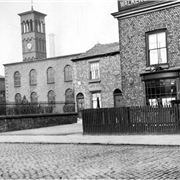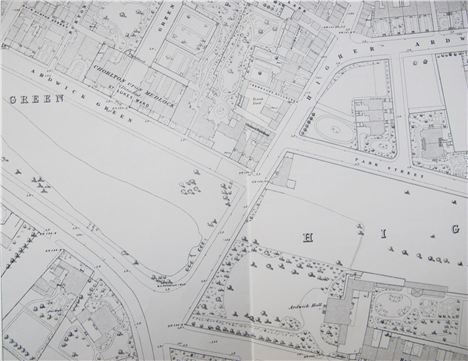LAST month planners gave permission for the Church Inn at Ardwick Green to be demolished and a nondescript three storey block of 20 apartments to be built on the site with basement car parking.
Ardwick Green is one of the city’s few historic squares, it is in a mixed residential neighbourhood lacking facilities and across the road from Brunswick, an area that is about to have £113m spent to build 500 new homes and refurbish existing ones.
This should have been a straightforward planning story pointing out shoddy design and the frustration of neighbourhood opposition but has turned into a sorry tale of missed opportunities and a lack of civic vision.
Because saying yes to this application has thwarted expansion plans of the St Thomas Conference Centre which occupies the Grade II listed eighteenth century church next door and effectively blocks any wider scale community development.
That the Centre is owned by Manchester City Council and leased on a peppercorn rent to Greater Manchester Centre for Voluntary Organisations only adds to the angst.
GMCVO wants to create more meeting rooms to meet demand and had plans drawn up and approved for an area of land that used to serve as the pub car park.
They had a benefactor who offered to help and when the pub was up for sale two years ago by Enterprise Inns tried to buy it but were outbid at auction by the current owners who are thought to have paid £210,000 for the site.
Ian Taylor is community hub manager and said: “It is frustrating that the area is losing a pub and we have had our expansion plans thwarted but it was a commercial deal. We had a couple of people prepared to buy the site and then sell us the bit of land we needed but unfortunately they were not successful. The plans that have just been passed show they need all the land so we are having to try and find a Plan B.
“The opportunity had been there for the Centre to become much more than it is at the moment and we do need more room to offer alternative accommodation. Voluntary Sector NW is based here now and as organisations have their funding cut there is the opportunity to base more here so we can rationalise services and consolidate overheads.
“We have a room that can hold 150 and smaller meeting rooms and need mid-sized spaces. The potential to expand what St Thomas’s can offer was frustratingly close but we now have to re-think our options.”
And with a listed building their options are limited. An earlier idea to build over the graveyard understandably met with cries of protest. Going into the roof maybe the only alternative.
Local residents would have liked to see the pub retained and the building converted to become a shop or some other community resource and fear the apartments will become student accommodation.
They are also worried that excavating for underground car parking will damage the area’s existing sewer system and damage housing.
The site is opposite Ardwick Green Park, a little oasis of green before the Apollo roundabout on Stockport Road and while it’s not a conservation area the railings round the park are listed.
 Dreary Apartments In Brick And Grey With Fake Georgian Door - cheap non-architecture of the worst kind
Dreary Apartments In Brick And Grey With Fake Georgian Door - cheap non-architecture of the worst kind
There are odd remnants of grand Georgian terraces, most of which are now offices and the Manchester Historic Buildings and Conservation Panel would like to see a better precedent set for buildings in gap sites on and around Ardwick Green with elegant, simple Georgian proportioned terraces of high quality design.
The site was bought by Salford based Sloegrin Properties which was founded two years ago as a property investment, development and management company and they revised the design a couple of times before getting planning approval.
One of the conditions is that they sign an agreement that the block will not be sold as student accommodation. The firm is currently developing a site on Broad Street, Salford to provide 34 student pods.
Their agent James Lloyd confirmed that they were just waiting for the necessary documents to be sent over from the town hall.
The pub is already shut and one of the reasons for granting permission was that the site would continue to deteriorate. The council report says: “The current condition of the building has had an impact on the character of the streetscene and its further deterioration will adversely affect the amenities of the area. The building, when in active use, contributed positively to the surrounding area. However, the building has been vandalised since its closure and will increasingly become a focus for anti-social behaviour.”
But despite getting consent it would seem nothing will happen in the near future.
Mr Lloyd said: “We will be looking at developing it out at some stage in the next three years but it is just going to be sat there until then."
I don’t blame Sloegrin for spotting the opportunity but I do blame the city for not seeing it in wider context. Ardwick Green is one of the city’s few historic squares, it is in a mixed residential neighbourhood lacking facilities and across the road from Brunswick, an area that is about to have £113m spent to build 500 new homes and refurbish existing ones.
The Church Inn plot could have been used to expand St Thomas’s, perhaps incorporating the old school just behind which is currently used as a photographers studio to provide a mix of community facilities. Add some housing, but make it family housing, respectful of the park.
According to Ian Taylor GMCVO is now working more closely with the Town Hall land and property team but sadly here it would seem to be too late.
The planning report is here.
 Ardwick Green - 1920s'Universally admired for the beauty of its appearance...' 1822 description of Ardwick Green area.
Ardwick Green - 1920s'Universally admired for the beauty of its appearance...' 1822 description of Ardwick Green area.
Ardwick Green used to be the Bowdon and Hale of central Manchester.
In fact it was far wealthier than that. Think a sort of mini-Mayfair.
In the first half of the nineteenth century many of Manchester's top industrialists - and therefore - the top global industrialists settled in the area.
Where the Green still stands in its rundown sorry state there was a serpentine lake, that can be glimpsed in outline on the left in the 1849 map below.
Nearby Ancoats is proud of its mills strung along Rochdale Canal and still surviving. Several of these were owned by McConnel and Kennedy. Both McConnel and Kennedy lived around the Green, Kennedy in Ardwick Hall which stood over the road close to the site of the present Apollo Theatre.
Round the corner was the home of William Fairburn the engineering giant, responsible for advances in boiler making and invention of the riveting machine and with Eaton Hodgkinson of the H-beam. The latter is the standard girder which is the ancestor of all the H-girders which support most large structures built in the last two hundred years.
When Mrs Banks in her famous novel The Manchester Man wanted somewhere for the wealthy Aspinall family to live she chose Ardwick Green. Naturally.
Charles Rowley, art-lover and local, watched on as the rich started to move out to places such as Hale in the later nineteenth century and despaired. The city leaders were fleeing the city, relinquishing their civic responsibilities as they fled.
"If God made the country, and Man made the town, then the Devil made the suburbs," he thundered.
(Jonathan Schofield)
 Ardwick Green 1849 map. Look at the size of these houses and gardens
Ardwick Green 1849 map. Look at the size of these houses and gardens










